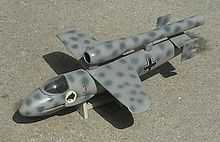Heinkel P.1077

Heinkel P.1077 (He P.1077) was a single seat interceptor design developed for the Luftwaffe by Heinkel under the Emergency Fighter Program during the last year of the Third Reich. This rocket-powered project was originally known as He P.1068,[1] but that name would later be used for a Heinkel design project for a turbojet-powered medium bomber.
Design and development
This airplane was one of the products of the last phase of the Third Reich, when the lack of materials and the dire need to put up a strong defense against the devastating allied bombing raids required such craft to be built as quickly as possible in underground factories. Comparable models were the Junkers EF 127 Walli and the Messerschmitt P.1104. In the design of such small aircraft little thought was given to the safety and comfort of the pilots who were intended mostly to be young Nazis motivated by fanaticism,[2] much as was intended for the Heinkel He 162.
The pilot would have flown the aircraft from a prone position. Takeoff was to be aided by four solid fuel RATO boosters which were jettisoned at burnout, and a jettisonable "trolley" sled for take-off. It would climb at a nearly vertical angle to operational altitude, after which the pilot would have only five minutes for combat action, before gliding the aircraft to land on a fixed skid.
By the end of the war only a model had been built. Two prototypes that had been planned, including one powered by a pulse jet engine instead of rockets, never proceeded past the project stage.[3]
Variants
- P.1077 Julia I and Julia II
- Rocket (Walter HWK 109-509) powered interceptor project.
- P.1077 Romeo
- Pulse-jet (Argus As 014) powered interceptor project.
Specifications (Projected - He P.1077 Julia)
General characteristics
- Crew: one
- Length: 6.47 m (21 ft 3 in)
- Wingspan: 4.60 m (15 ft 1 in)
- Height: 1.00 m (3 ft 3 in)
- Wing area: 7.30 m2 (78.6 sq ft)
- Max takeoff weight: 1,800 kg (3,968 lb)
- Powerplant: 1 × Walter HWK 109-509 , 17 kN (3,800 lbf) thrust
- Powerplant: 4 × take-off rockets , 12 kN (2,700 lbf) thrust each
Performance
- Maximum speed: 1,000 km/h (621 mph; 540 kn)
- Time to altitude: 10,000 m in 52 seconds
- Guns: 2x 30 mm (1.181 in) MK 108/20 cannon
See also
References
External links
| Wikimedia Commons has media related to Heinkel P.1077. |
| ||||||||||||||